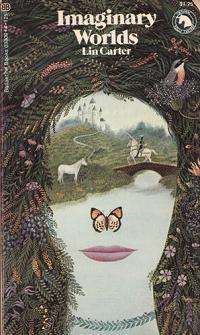Imaginary Worlds: The Art of Fantasy
Imaginary Worlds: the Art of Fantasy is a study of the modern literary fantasy genre written by Lin Carter. It was first published in paperback by Ballantine Books in June, 1973 as the fifty-eighth volume of its Ballantine Adult Fantasy series; it was the only nonfiction entry in the series. The book was among the earliest full-length critical works devoted to fantasy writers and the history of fantasy. It was the third of three such studies by Carter, being preceded by Tolkien: A Look Behind "The Lord of the Rings" (1969) and Lovecraft: A Look Behind the "Cthulhu Mythos" (1972). These works, together with his editorial guidance of the Ballantine Adult Fantasy series, established Carter as an authority on the genre.
 Cover of the first edition | |
| Author | Lin Carter |
|---|---|
| Cover artist | Gervasio Gallardo |
| Country | United States |
| Language | English |
| Series | Ballantine Adult Fantasy series |
| Publisher | Ballantine Books |
Publication date | 1973 |
| ISBN | 0-345-03309-4 |
| Preceded by | Lovecraft: A Look Behind the "Cthulhu Mythos" |
Carter's study was intended to serve as an introduction to fantasy. The first eight chapters detail the history of the modern genre from the late nineteenth century through the early 1970s, when Carter was writing, a subject he had previously covered more briefly in Tolkien: A Look Behind "The Lord of the Rings". Its origins are discovered in the novels of William Morris, and followed through the writings of Lord Dunsany, E. R. Eddison and James Branch Cabell. Separate attention is then devoted to the subsequent development of fantasy in America and Britain, focusing on the pulp magazine tradition in the former and the continuing dominance of the more literary tradition in the latter. The work of contemporary fantasists is then detailed. Three additional chapters form a sort of "how to" course on the writing of fantasy, illustrated with examples from Carter's own writings. (Some of these, like The White Throne and Khymyrium, bear the peculiar interest of being works in progress or projected that in the event were never published in complete form.) Bibliographies of general references and the Ballantine Adult Fantasy series complete the study.
Contents
- Introduction: The Empire of Imagination…
- From Uruk to Utterbol: William Morris and the First Fantasy Novels
- The World’s Edge, and Beyond: The Fiction of Dunsany, Eddison, and Cabell
- Lost Cities, Forgotten Ages: The Rise of Fantasy in the American Pulp Magazines
- The Mathematics of magic: Imaginary Worlds Fantasy in Unknown
- From The Night Land to Narnia: The Road to The Lord of the Rings
- The Inklings Produce a Classic: The Achievement of Tolkien and His Influence
- Post-Howardian Heroica: The Swordsman and Sorcerers’ Guild of America, Ltd
- The Young Magicians: Some Modern Masters of Fantasy
- Of World-Making: Some Problems of the Invented Milieu
- A Local Habitation and a Name: Some Observations on Neocogomina
- The Tricks of the Trade: Some Advanced Techniques of World-Making
- Bibliography I: General References
- Bibliography II: The Adult Fantasy Series
- Index